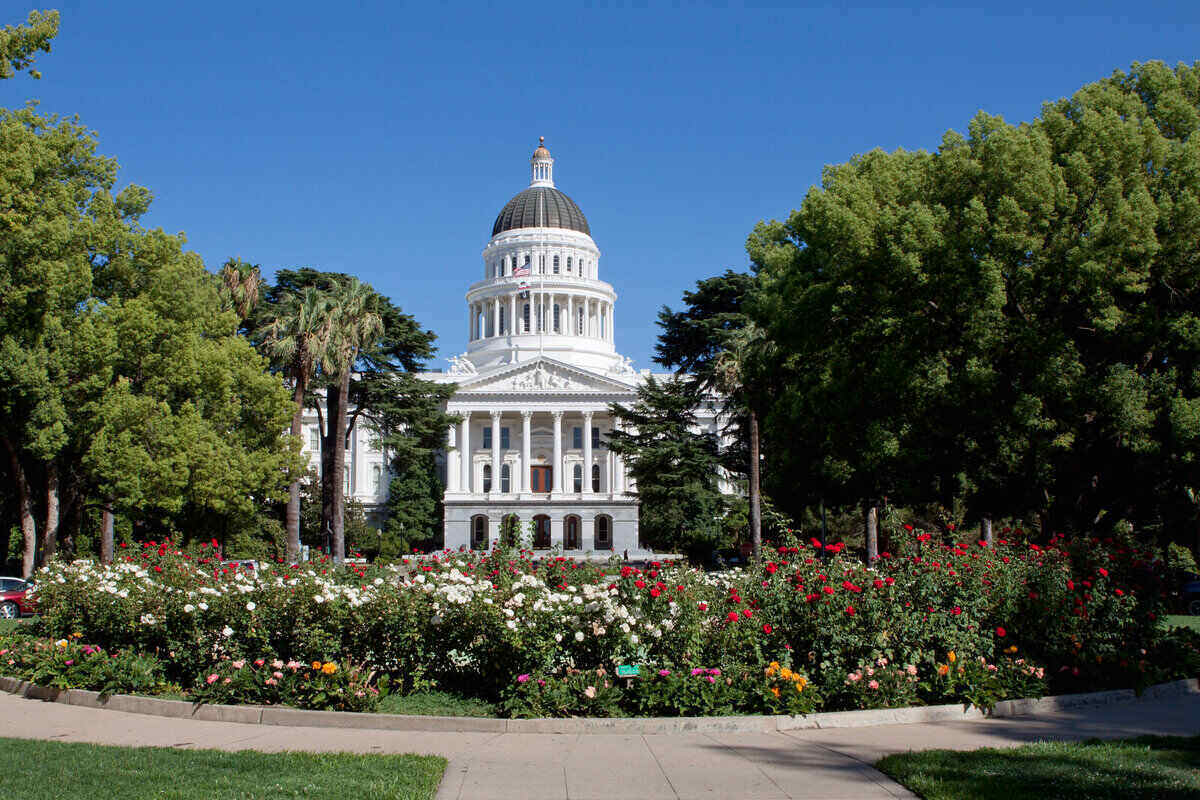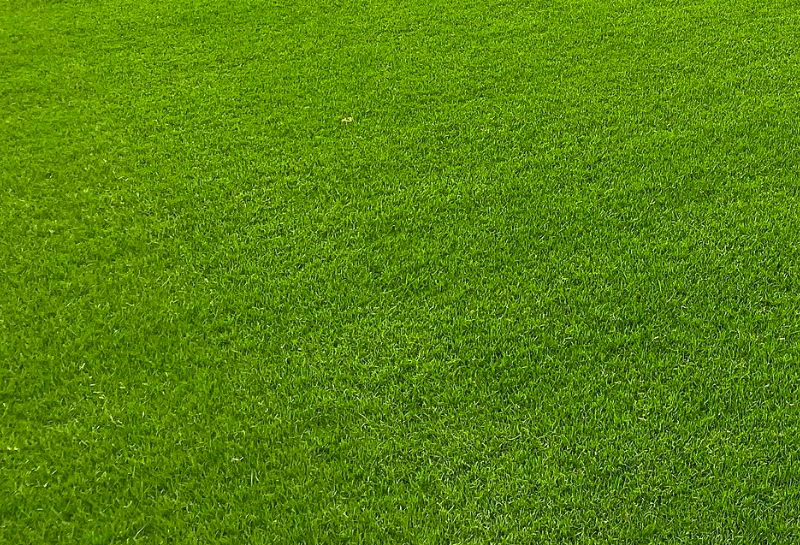
As the capital city, Sacramento is home to many sights, sounds, and smells, but does the view of your lawn leave something to be desired? We’ve got four grass types that will help your lawn look worthy of its capital surroundings.

Gilba Solutions Pty Ltd | Wikimedia Commons | CC BY-SA 4.0
1. Bermudagrass
North of the Bay Area, you’ll often see cool-season grass types, so you may wonder why bermudagrass, a warm-season species, is on the list. Despite its low tolerance for cold (and winter dormancy), bermudagrass thrives in Sacramento’s warm summers. It must have full sun and is a great lawn if you like to entertain or have lots of foot traffic on the lawn.
Bermudagrass spreads aggressively, so be sure to border your ornamental beds with hard edging that goes down into the soil at least 2 inches.
- Classification: Warm-season grass
- Spreads by: Stolons and rhizomes
- Shade tolerance: Low
- Drought tolerance: High
- Foot traffic tolerance: High
- Maintenance needs: Common (aka “improved”) cultivars are ideal for home lawns and require less maintenance than hybrid cultivars, which are used more often as sports turf and need a high level of care.
- Mowing height: 1-2 inches
- Potential for disease: Moderate (depends on the cultivar)
Other notes: Bermudagrass, like most warm-season grasses, will turn brown during the winter. There are several cultivars on the market, each with different strengths and weaknesses, so do your homework before you buy.
Grass Seed Options:
– Pennington Bermudagrass Bare Spot (5 lb. bag)
– Pennington Smart Seed Bermudagrass Mix (8.75-lb. bag)
– Scotts Turf Builder Bermudagrass (10-lb. bag)
– Hancock Seed Co. Bermudagrass (50-lb. bag)
2. California buffalograss
Buffalograss has lived on the U.S. prairies for an untold number of years and has excellent drought tolerance. Until recently, cultivars for home lawns have been limited, though. In 2003, the California buffalograss cultivar hit the commercial market and has become a viable low-maintenance grass for home and commercial use throughout the state.
Originally known as ‘UC Verde’ buffalograss, this cultivar requires up to 75% less water than other turf species. How often you mow is up to you: You can mow as little as once per year, or you can mow it once every few weeks for a more manicured appearance. Once established, it forms a dense stand of grass and resists weed invasion, but you’ll have to keep weeds in check as it becomes established.
- Classification: Warm-season grass
- Spreads by: Stolons
- Shade tolerance: Low
- Drought tolerance: High; may go brown (dormant) if not irrigated in the summer; requires ½” of water per week.
- Foot traffic tolerance: Moderate
- Maintenance needs: Low
- Mowing height: Personal preference; naturally grows from 4”-6”
- Potential for disease: Low
Other notes: It will turn brown in winter. Some homeowners use grass paint to maintain a green color during the colder months. California buffalograss produces very little pollen, so it is great grass for allergy sufferers.
3. Unmowed grass blends
There are several different brands and combinations of unmowed grass blends. These blends are touted as low-maintenance, low-input, which makes the marketing attractive to many homeowners.
Most blends will be a combination of two or more fine fescues. These blends are sold as seed or sod, and some single species (like hard fescue) are sold as sod. Fine fescues work well in shade and poor soils and are marketed for low- or no-traffic lawns. They don’t tolerate the sun, especially in Sacramento’s hot summers. These blends often do well if left unmowed, but you’ll have to irrigate them if you want them to stay green during the summer months.
It’s difficult to determine the exact tolerances for these blends since each brand will have a different formula, so we’ve left out the highlighted characteristics for grass blends. Read the instructions carefully, and read which grass types each blend includes. You can then look online or contact your Sacramento County Extension Office to make sure you’re making the best selection.

Ty Haller | Flickr | CC BY-SA 2.0
4. Tall fescue
Tall fescue is the most popular home lawn grass in California. It has few insect problems, can tolerate partial shade, and is relatively low-maintenance. It may struggle in the summer months, so be prepared to give it additional water if you want it to remain green. Tall fescue is available as seed or sod and likes deep but infrequent watering once established.
- Classification: Cool-season grass
- Spreads by: Bunch-type grass
- Shade tolerance: Moderate
- Drought tolerance: High, meaning it won’t likely die, but you’ll need to irrigate to maintain its green color in the summer
- Foot traffic tolerance: Moderate, but doesn’t recover well
- Maintenance needs: Low
- Mowing height: 1.5-3 inches
- Potential for disease: Low
Other notes: You may want to check out the newer, improved varieties of tall fescue: turf-type tall fescues and dwarf turf-type tall fescues. Sometimes you’ll find tall fescue/bluegrass mixes as well. Cool-season mixes are often developed to take advantage of the strengths of each grass and minimize the weaknesses.
Grass Seed Options:
– Triple-Play Tall Fescue Grass Seed Blend (5000 sq ft)
– Eretz Kentucky 31 K31 Tall Fescue Grass Seed (choose your size)
– Pennington The Rebels Tall Fescue Grass Seed Mix (7 lb.)
How to select the best grass type for your Sacramento lawn
Consider a few things about your lawn before you shell out money for new grass:
- Do you want a high-maintenance or low-maintenance lawn?
- The unmowed grass blends and California buffalograss have low levels of maintenance. Bermudagrass and tall fescue will require a little more of your time.
- What kind of sun or shade does your lawn have?
- The unmowed grass blends usually have one or more types of fine fescue, which love the shade, and tall fescue can handle some shade. California buffalograss and bermudagrass need full sun.
- How much watering do you want to do?
- California buffalograss needs the least amount of water, while the other types require more irrigation, especially during the summer.
- Do people or pets put a lot of wear on your lawn?
- Bermudagrass is a clear winner if you have lots of foot traffic on your lawn. Tall fescue and California buffalograss fall in the middle, and unmowed fine fescues are usually marketed as no-traffic lawns.
If you’d rather spend your weekends enjoying a local farm-to-fork restaurant with friends or browsing around this capital city with a cup of coffee, let one of our Sacramento lawn care pros take lawn care off your weekend to-do list.
Main Photo Credit: Jirka Matousek | Flickr | CC BY 2.0
Lawn Love participates in the Amazon Services LLC Associates Program, an affiliate advertising program. Lawn Love may earn revenue from products promoted in this article.